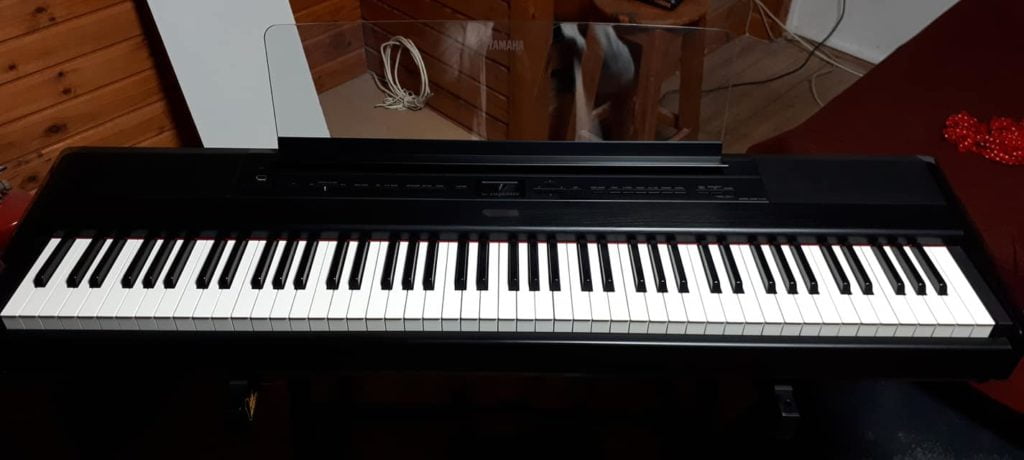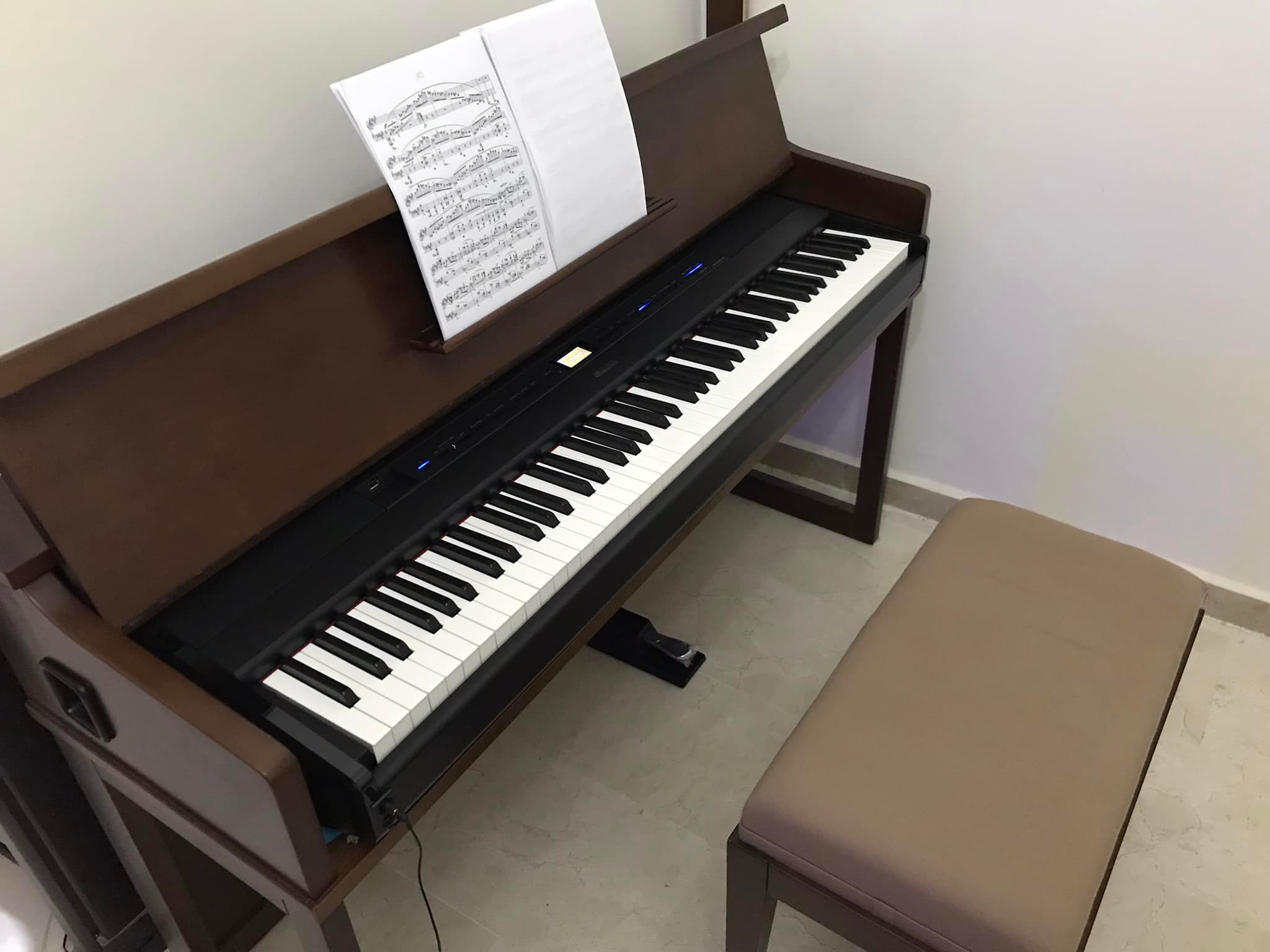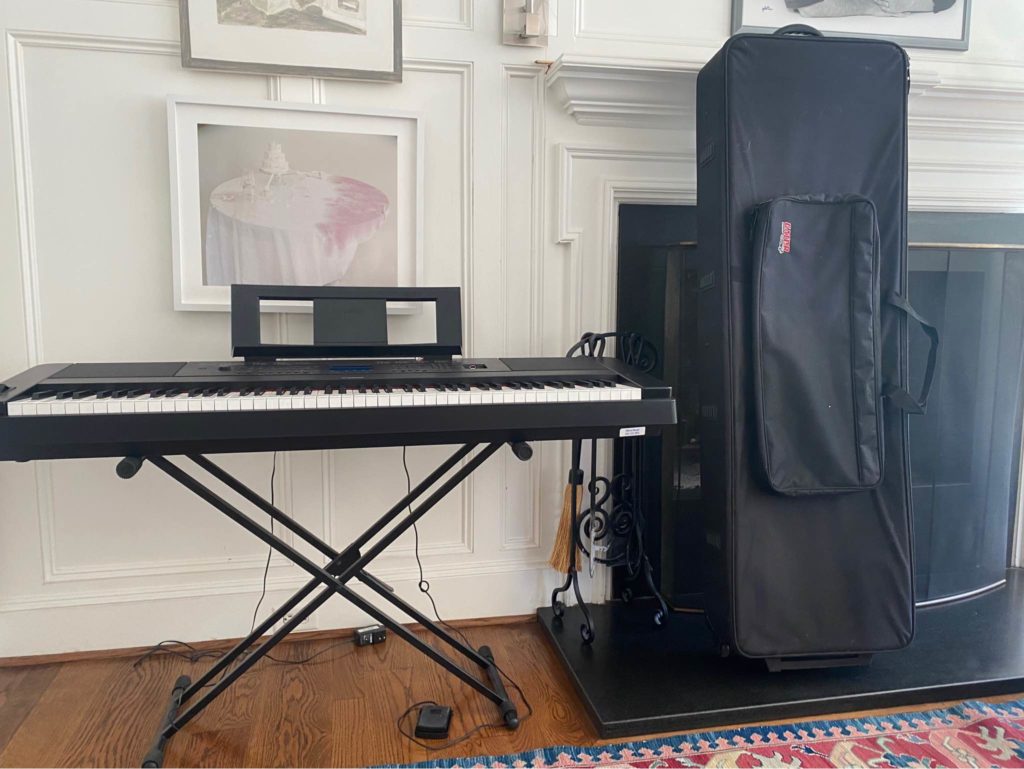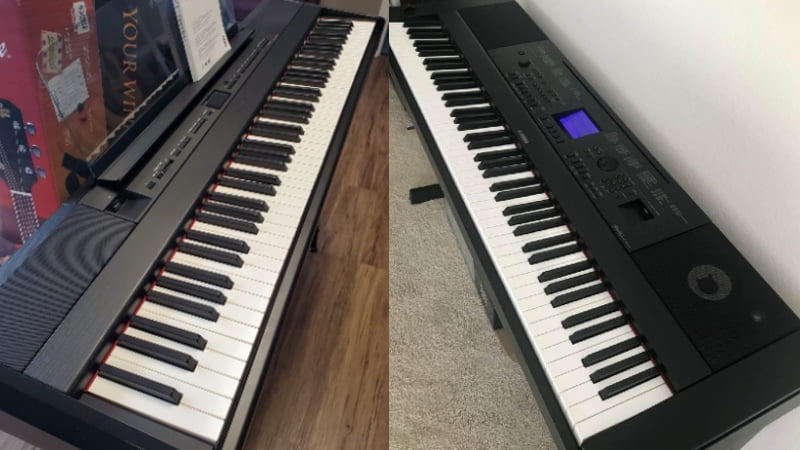Find out if the Yamaha P515 is really worth the price compared to other Yamaha pianos in this Yamaha DGX-660 vs P515 review.
Making this Yamaha DGX-660 vs P515 review was a whole lot of fun. Both of these pianos are easily some of the best options available, with various features, offering a lot of value for the money. But since the P515 is far more expensive than the DGX-660, it has more to offer.
The Yamaha DGX-660 put up a great fight in this comparison, but there was nothing it could do to compete with the P515. While I usually say that the more expensive piano isn’t always the better option, that is definitely the case in this comparison.
That said, even if I found the P515 to be the better piano, there are many pianists (particularly beginners and novice players) that will see the DGX-660 as the better option. And if you want to learn which piano is right for you, you’ve come to the right place.
In this article, we’re going through all the features and differences between both pianos while also explaining who would benefit the most from either instrument. And by the end, you’ll know exactly which piano sutis your needs and which one you should invest in!
Yamaha DGX-660 vs P515: Comparison Chart




Last update on 2025-04-13 / Affiliate links / Images from Amazon Product Advertising API
Yamaha DGX-660 vs P515: A Head to Head Comparison
There are three comparison points I always use when putting two digital pianos against each other. These are the tone, feel, and polyphony. This may not come as a surprise, but the Yamaha P515 won almost all of these comparison points, so the final score was 3-1, with the P515 taking the cake.
But how did this happen?
Below, I’ll explain exactly how the Yamaha P515 beat out the DGX-660 and whether or not you really need all these features. Read on to learn more.
Tone
The winner: Yamaha P515
I always start these reviews with a tone comparison. And despite the DGX-660’s best efforts, it couldn’t compete with the P515’s tone. This is because the P515 comes with more sophisticated tone engines that result in a more detailed and brighter sound. Admittedly, the DGX-660’s sound library is wider than the P515’s, which is great for pianists that want variety. So, in the end, I gave a point to both pianos.
+Tone Generation

The Yamaha P515 uses multiple tone engines, which are the Yamaha CFX, Bosendorfer Imperial, and CFX Binaural Sampling. This piano uses different tone engines for various voices, which gives you more realism and clarity, which is why I prefer the tone quality of the P515.
The first tone engines are the Yamaha CFX and CFX Binaural sampling. This basically means that the piano gets its tones from Yamaha CFX pianos, which are some of the most sought-after grand pianos in the industry. This is why almost all the piano tones on the P515 are very high-quality and can compete with some of the most expensive models on the market.
Additionally, the Yamaha P515 also uses the Bosendorfer Imperial tone engine. This means that the piano also has samples recorded from the Bosendorfer piano, which is one of the only instruments that can compete with the CFX Grand Pianos’ quality.
On the flip side, the DGX-660 uses the Pure CF Sound Engine for its piano tones. This means that you get a similar but not quite as detailed piano tone with the DGX-660, which is more than enough for most beginners and novice pianists.
That said, if you’re looking for the most realistic tones possible, I highly recommend the P515. I couldn’t find that many pianos that can compete with its tone quality, which is something that you need to consider when choosing between these two models.
+Sound Library
The next aspect of the tone I compared was the variety. The Yamaha P515 has 40 voices, along with 18 drum kits. This gives you a lot of variety which is great for professional pianists. You can easily cycle between a range of the piano, strings, organ, bass, and other voices. And with the drum kit, you can add a bit of percussion to your playing, which can come in handy if you don’t have a drummer in the band.
That said, the DGX-660 has a sound library with over 500 different tones, which is more than you will ever need as a pianist. So, you can expect this piano to have just about any sound you’d want to play in various genres.
However, not all of these voices come from the Pure CF Sound Engine. This is why I noticed a significant dip in quality when cycling through the tones. And while this isn’t a deal-breaker, it’s definitely something to consider if you plan on buying this piano.
Feel
The winner: Yamaha P515

The Yamaha P515 is the flagship model of the P-series, which is the main reason it comes with some of the best features from the brand. This includes the hammer action, as the P515 comes with the Natural Wood X hammer action system, which is far superior to the GHS you will find on the Yamaha DGX-660. And because of this sophisticated hammer action system, the Yamaha P515 easily took the point.
+Hammer Action
The hammer action system of the DGX-660 is no joke. This piano comes with the Graded Hammer Standard or GHS, which is one of Yamaha’s best hammer action systems. This system aims to replicate the feel of a real acoustic piano by having the bass keys a bit heavier than the treble keys, which is a great detail that I really appreciated.
And while I was very impressed by the hammer action on the DGX-660, it couldn’t beat the wooden keys on the Yamaha P515. Aside from having a very realistic weight to them, you can instantly tell that the keys are wooden because of the texture.
This adds a whole new layer of realism to your playing that you really won’t find with other models, even at higher price points. If you’re trying to save a bit of money, the GHS system on the DGX-660 is more than okay. However, if you’re willing to spend more money for an added layer of realism, the P515 is easily worth the investment.
Polyphony
The winner: Yamaha P515
The last feature I compared was the polyphony. While many people overlook this feature when buying a digital piano, it’s one of the most important things to consider.
Polyphony refers to the piano’s ability to play multiple notes simultaneously. So, the higher the polyphony, the better. This is especially true if you’re playing multiple voices at the same time, sustaining notes with the pedal, or if you’re playing dense chords and melodies.
Pianos with lower polyphony don’t provide the same clarity and sustain as those with higher polyphony. And even if the Yamaha DGX-660 comes with a decent polyphony of 196 notes, it still doesn’t beat the P515, which has 256-note polyphony.
Again, the P515 is the flagship model of Yamaha’s portable pianos, so it has some of the best features from the brand. This is why I would always recommend this piano over the DGX-660, even if I believe that the DGX-660 is still a great piano that offers a lot of value for the money.

Yamaha DGX-660 vs P515: The Similarities
These are very different pianos. One is designed for novices and beginners (the DGX-660), while the other is a flagship model designed for serious musicians. That said, both pianos still share a couple of notable similarities.
For example, they are both portables. This gives you much flexibility as you can bring this piano virtually anywhere. Of course, since they are full 88-key keyboards, they will be a bit bulky and heavy. However, these are still great options for anyone that needs to bring instruments to gigs and other events.
Both pianos also offer various playing modes and a great set of effects. Again, the Yamaha P515 is a bit more of a workhorse as it’s the product line’s flagship model. However, the DGX-660 still offers great value for the money and would make a great piano for just about any player out there.
Quick Rundown of the Yamaha DGX-660
- The Pure CF Sound Engine faithfully reproduces the tone of a meticulously sampled and highly acclaimed Yamaha concert grand piano
- GHS weighted action is heavier in the low register and lighter in the high, just like an acoustic piano
- Score display puts music notation of MIDI songs on the screen, helping you play your favorites by following the bouncing ball
- The Piano room lets you choose from a variety of pianos and acoustic settings to create your own personal piano environment
- The 6 track recorder allows you to capture your performances and song ideas, then add additional layers to spice up your pieces
Last update on 2025-04-14 / Affiliate links / Images from Amazon Product Advertising API
Quick Rundown of the Yamaha P515
- Yamaha CFX and Bösendorfer Imperial piano samples bring two of the world's finest and most prominent concert grand pianos to your fingertips
- The Piano Room lets you choose from a variety of pianos and acoustic settings to create your own personal piano environment
- Virtual Resonance Modeling (VRM) allows for vivid and richly-varied expression to reflect the limitless number of factors that create the sound of a concert grand piano
- Natural wood keyboard action with escapement and synthetic ebony/ivory key tops utilize specially dried wood to provide the same response and feel of a grand piano keyboard
- Key-off samples deliver the delicate change in sound the instant the damper falls back to the string.Number of Polyphony (Max.):256
Last update on 2025-04-13 / Affiliate links / Images from Amazon Product Advertising API
Product Video
Related Articles to Yamaha Dgx 660
- Yamaha YDP-164 vs DGX-660: Why You Should Go for the DGX-660
- Yamaha DGX-660 vs Roland FP-90: Why the Roland FP-90 Is the Better Pick
- Yamaha DGX-530 vs 660: Why the DGX-660 Is the Better Pick
- Yamaha DGX-505 vs 660: Why the DGX-660 Is the Better Pick
- Yamaha DGX-660 vs DGX-640: A DGX Comparison
- Yamaha DGX-660 vs DGX-630: A DGX Comparison
- Yamaha DGX-620 vs 660: Finding the Best DGX Model
- Yamaha DGX-660 vs YDP-163: Which Is the Better Piano?
- Yamaha DGX-660 vs Roland Juno DS-88: Which Is the Better Piano?
- Yamaha DGX-660 vs Casio PX-360: Which Is the Better Piano?
- Yamaha DGX-660 vs YDP-144: Which Is the Better Yamaha Piano?
- Yamaha DGX-660 vs Korg Havian 30: Which Is the Better Digital Piano?
- Yamaha DGX-660 vs Casio CGP-700: Which Is the Better Pick?
- Yamaha DGX-660 vs YPG-535: Finding the Best Yamaha Digital Piano
- Yamaha DGX-660 vs P-115: Which Yamaha Model Is Better?
- Yamaha DGX-660 vs Casio PX-560: Which Piano Offers More Value For The Money
- Yamaha DGX-660 vs 650: A DGX Comparison
- Korg XE-20 vs Yamaha DGX-660: Finding the Best Digital Piano
- Yamaha P45 Vs DGX-660: A Head-to-Head Comparison
- Yamaha DGX 670 Vs 660: The Distinct Difference In Details You Need To Know About
- Yamaha YDP-103 Vs DGX-660: Which Is The Better Yamaha Piano?
- Casio PX-770 Vs Yamaha DGX-660: Should You Get A Portable Or Console Digital Piano?
- Yamaha P71 vs DGX-660: Can the Amazon Exclusive Beat Out the Premium Model?
- Yamaha P125 vs DGX 660 Comparison: Can the P125 Hold Its Own Against the DGX 660?
Related Articles to Yamaha P515
- Yamaha DGX 670 Vs P515: Which Gives You Bang For Your Buck?
- Yamaha P125 vs P515 Review: Why the Yamaha P515 Is the Better Investment
References:
- Yamaha DGX-660: https://europe.yamaha.com/en/products/musical_instruments/pianos/portable_grand/dgx-660/specs.htmlv
- Yamaha P515: https://www.sweetwater.com/store/detail/P515WH–yamaha-p515wh-digital-piano-white
Lulacruza is an electronic folk duo operating at the junction of the hypermodern and the ancient. Our music weaves together hypnotic female singing, South American folk instruments and electronic processing, while channeling pulsating waves from the source of creation.
Lalucruza is also a community where you can connect with other music lovers to collaborate, exchange ideas and share knowledge. A platform for who wants to learns the basics of playing piano, guitar, drum masters’ technique, etc.. is the premise of our website.
